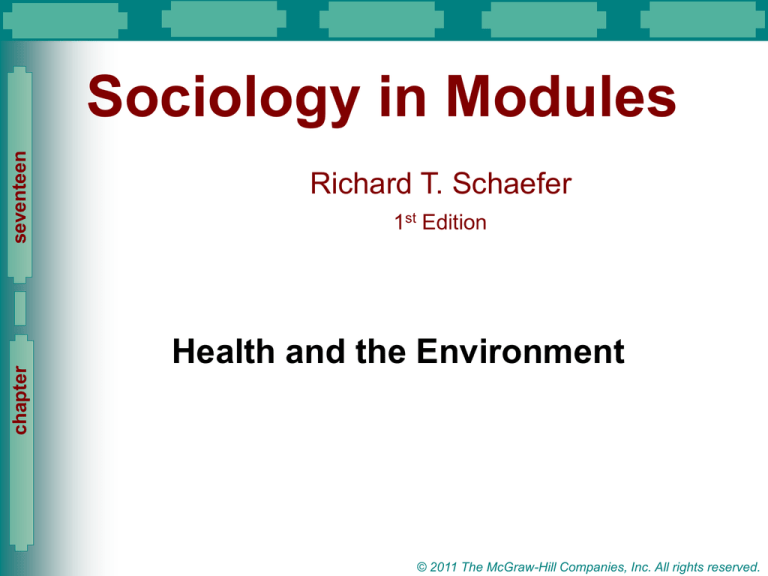
Slide 1
chapter
seventeen
Sociology in Modules
Richard T. Schaefer
1st Edition
Health and the Environment
© 2011 The McGraw-Hill Companies, Inc. All rights reserved.
Slide 2
Health and
the Environment
17
•Module 51: Sociological
Perspectives on Health
•Module 52: Social Epidemiology and Health
•Module 53: Health Care in the United States
•Module 54: Sociological
Perspectives on the Environment
© 2011 The McGraw-Hill Companies, Inc. All rights reserved.
Slide 3
A Look Ahead
█
█
█
Won’t the environment eventually
threaten everyone, no matter how
much organic food they consume?
What defines a
healthy environment?
How does health care vary
from one social class to another?
© 2011 The McGraw-Hill Companies, Inc. All rights reserved.
Module 51
Slide 4
Culture and Health
█
Culture-bound syndrome: Disease or
illness that cannot be understood apart
from its specific social context
– Anorexia nervosa
Medical practitioners are
being trained to recognize
cultural beliefs related to medicine
© 2011 The McGraw-Hill Companies, Inc. All rights reserved.
Module 51
Slide 5
Table 51-1: Cultural Challenges to Medicine
© 2011 The McGraw-Hill Companies, Inc. All rights reserved.
Module 51
Slide 6
Sociological Perspectives
on Health and Illness
█
Health: “State of complete physical,
mental, and social well-being, and not
merely the absence of disease and
infirmity” (Leavell and Clark 1965:14)
Health is relative, and we
can view it in a social context
© 2011 The McGraw-Hill Companies, Inc. All rights reserved.
Module 51
Slide 7
Figure 51-1: Infant Mortality Rates in Selected Countries
© 2011 The McGraw-Hill Companies, Inc. All rights reserved.
Module 51
Slide 8
Functionalist Approach
█
“Being sick” must be controlled so
not too many people are released
from their societal responsibilities
– Sick role: Societal expectations
about attitudes and behavior of
a person viewed as being ill
– Physicians function as
“gatekeepers” for the sick role
© 2011 The McGraw-Hill Companies, Inc. All rights reserved.
Module 51
Slide 9
Conflict Approach
█
Medicalization of society:
Growing role of
medicine as major
institution of social control
– Greatly expanded
domain of expertise
– Problems viewed
using a medical model
– Retains jurisdiction
over health care
© 2011 The McGraw-Hill Companies, Inc. All rights reserved.
Module 51
Slide 10
Conflict Approach
█
Inequities in Health Care
– Obvious inequities exist in health care
– Brain drain: Immigration to U.S. and
other industrialized nation of skilled
workers, professionals, and technicians
– Dramatic differences in infant
morality rate: Number of deaths
of infants under one year old
per 1,000 live births in given year
© 2011 The McGraw-Hill Companies, Inc. All rights reserved.
Module 51
Slide 11
Interactionist Approach
█
█
Studies roles played
by health care
professionals
and patients
Asserts patients
may play an active
role in positive
or negative health
© 2011 The McGraw-Hill Companies, Inc. All rights reserved.
Module 51
Slide 12
Labeling Approach
█
The designations healthy and ill
generally involve social definition
– Homosexuality noteworthy
medical example of labeling
– Can view variety of life
experiences as illnesses or not
© 2011 The McGraw-Hill Companies, Inc. All rights reserved.
Module 51
Slide 13
Table 51-2: Sociological
Perspectives on Health and Illness
© 2011 The McGraw-Hill Companies, Inc. All rights reserved.
Module 52
Slide 14
Social Epidemiology
and Health
█
█
Social epidemiology: Study of
distribution of disease, impairment, and
general health status across a population
Incidence: Number of new cases
of a specific disorder occurring
within a given population during
a stated period of time, usually a year
© 2011 The McGraw-Hill Companies, Inc. All rights reserved.
Module 52
Slide 15
Social Epidemiology
and Health
█
Prevalence: Number of cases of
specific disorder that exist at a given time
Morbidity rates: Disease incidence
figures presented as rates or number
of reports per 100,000 people
█ Mortality rate: Incidence
of death in a given population
█
© 2011 The McGraw-Hill Companies, Inc. All rights reserved.
Module 52
Slide 16
Social Class
█
People in lower classes have higher
rates of mortality and disability
– Appear to be cumulative
– Less able to afford quality medical care
– Link between health and economic mobility
© 2011 The McGraw-Hill Companies, Inc. All rights reserved.
Module 52
Slide 17
Race and Ethnicity
█
Health profiles of racial and ethnic
groups reflect social inequality in U.S.
– Poor economic and environmental
conditions manifested in high
morbidity and mortality rates
– African Americans have higher death rates
– Mexican Americans may use curanderismo:
Form of holistic health care and healing
© 2011 The McGraw-Hill Companies, Inc. All rights reserved.
Module 52
Slide 18
Gender
█
Women experience higher prevalence of
many illnesses but tend to live longer
– Lower rate of cigarette smoking
– Lower alcohol consumption
– Lower rate of employment
in dangerous occupations
– Women more likely to seek treatment
© 2011 The McGraw-Hill Companies, Inc. All rights reserved.
Module 52
Slide 19
Age
█
Most older people in U.S.
have at least one chronic illness
– Older people vulnerable to certain
types of mental health problems
Older people use more
health services than younger people
© 2011 The McGraw-Hill Companies, Inc. All rights reserved.
Module 52
Slide 20
Figure 52-1: People Living with HIV
© 2011 The McGraw-Hill Companies, Inc. All rights reserved.
Module 52
Slide 21
Figure 52-2: Percentage of
People without Health Insurance
© 2011 The McGraw-Hill Companies, Inc. All rights reserved.
Module 52
Slide 22
Figure 52-3: Availability of Physicians by State
© 2011 The McGraw-Hill Companies, Inc. All rights reserved.
Module 52
Slide 23
Research Today
█
The AIDS Epidemic
– Do the people you know take few
risks sexually because of the
danger of becoming infected with
the AIDS virus? If not, why not?
– Aside from obvious humanitarian
reasons, why should the U.S. help
countries in the fight against AIDS?
© 2011 The McGraw-Hill Companies, Inc. All rights reserved.
Module 53
Slide 24
Health Care
in the United States
█
Health care costs skyrocketed in 35 years
– In 2000, amount spent on
health care equaled that
spent on education,
defense, prisons, farm
subsidies, food stamps,
and foreign aid combined
© 2011 The McGraw-Hill Companies, Inc. All rights reserved.
Module 53
Slide 25
A Historical View
█
“Popular health movement”
of the 1830s and 1840s emphasized
preventive care and “self-help”
– AMA institutionalized authority through
programs of education and licensing
– By 1920s, physicians controlled hospital
technology, division of labor of health
personnel, and other health professions
© 2011 The McGraw-Hill Companies, Inc. All rights reserved.
Module 53
Slide 26
Physicians,
Nurses, and Patients
█
Physicians have position of
dominance with patients and nurses
– Leads to dehumanizing
physician-patient encounters
– Publicity about malpractice suits and high
medical costs further strained relationship
– Controlled interactions with nurses
– Increasingly, patients turning
to media for health care information
© 2011 The McGraw-Hill Companies, Inc. All rights reserved.
Module 53
Slide 27
Figure 53-1: Total Health Care Expenditures
in the United States, 1970-2019 (projected)
© 2011 The McGraw-Hill Companies, Inc. All rights reserved.
Module 53
Slide 28
Research Today
█
Medicine, Retail Style
– Have you ever been treated at an
in-store clinic? If so, were you
satisfied with the care you
received? Was the price reasonable?
– Evaluate the emergence of clinics from a
functionalist and then a conflict
perspective. On balance, do you think
these clinics are a benefit to society?
© 2011 The McGraw-Hill Companies, Inc. All rights reserved.
Module 53
Slide 29
Alternatives to
Traditional Health Care
█
At least one of three adults in
U.S. attempts to maintain good
health or respond to illness through
alternative health care techniques
– Holistic medicine: Therapies in
which the health care practitioner
considers person’s physical, mental,
emotional, and spiritual characteristics
© 2011 The McGraw-Hill Companies, Inc. All rights reserved.
Module 53
Slide 30
Figure 53-3: Use of Complementary
and Alternative Medicine
© 2011 The McGraw-Hill Companies, Inc. All rights reserved.
Module 53
Slide 31
The Role of Government
█
In 1946 Hill-Burton Action
provided first subsidies for
building and improving hospitals
– 1965: Medicare and Medicaid established
– Programs greatly expanded federal
involvement in health care financing
1983: Government
instituted cost-control program
© 2011 The McGraw-Hill Companies, Inc. All rights reserved.
Module 53
Slide 32
The Role of Government
█
Expansion of health insurance
coverage enacted by Congress
in 2010 raised hope of
improved health care
– Costs of the legislation,
Tea Party members warned,
would lead to higher taxes
© 2011 The McGraw-Hill Companies, Inc. All rights reserved.
Module 54
Slide 33
Sociological Perspectives
on the Environment
█
Environment people live in has
noticeable effect on their health
– Increases in population,
together with economic
development, have serious
environmental consequences
© 2011 The McGraw-Hill Companies, Inc. All rights reserved.
Module 54
Slide 34
Effects of Growth
and Development
█
Human ecology: Interrelationships
between people and their spatial
settings and physical environments
1. Environment provides
resources essential for life
2. Environment serves
as a waste repository
3. Environment “houses” our species
© 2011 The McGraw-Hill Companies, Inc. All rights reserved.
Module 54
Slide 35
Conflict View of
the Environment
█
Growing share of human and natural
resources of developing countries
redistributed to core industrialized nations
– Environmental justice: Legal claims that
racial minorities are disproportionately
subjected to environmental hazards
Poor and oppressed bear brunt
of environmental pollution
© 2011 The McGraw-Hill Companies, Inc. All rights reserved.
Module 54
Slide 36
Environmental Problems
█
Three broad areas
of concern
– Air pollution
– Water pollution
– Global Warming
© 2011 The McGraw-Hill Companies, Inc. All rights reserved.
Module 54
Slide 37
Sociology in
the Global Community
█
The Mysterious Fall of the Nacirema
– Have you ever visited a foreign
culture and been struck by
something that seemed odd to you but
perfectly normal to everyone else?
– If we could step back and take an
objective look at what we are doing to the
environment, would our society change
for the better? Why or why not?
© 2011 The McGraw-Hill Companies, Inc. All rights reserved.
Module 54
Slide 38
The Impact of Globalization
█
Globalization can be good
and bad for the environment
– Industrialization increased pollution
– Multinational corporations have incentive to
carefully consider cost of natural resources
– Environmental refugees are one
reflection of interplay between
globalization and environment
© 2011 The McGraw-Hill Companies, Inc. All rights reserved.
Module 54
Slide 39
Environmentalism
█
Understanding the Issue
– 1970: 25 million people turned
out to observe first Earth Day
– Citizens marched on behalf of
specific environmental causes
– Congress established the EPA
– The Clean Air, Clean Water, and
Endangered Species acts followed
© 2011 The McGraw-Hill Companies, Inc. All rights reserved.
Module 54
Slide 40
Environmentalism
█
Understanding the Issue
– Earth Day now on calendars of city
councils, zoos, and museums worldwide
– Increasingly, efforts to publicize
concerns moving to Internet
– General public has mixed
reaction to environmental issues
– Largest environmental organizations
became increasingly bureaucratic
© 2011 The McGraw-Hill Companies, Inc. All rights reserved.
Module 54
Slide 41
Environmentalism
█
Applying Sociology
– Troubled that most powerful environmental
organizations predominantly white, maledominated, and affluent
– Conflict perspective: major organizations
accept funding from powerful corporations
including oil and chemical companies
– Environmental movement aroused resistance
© 2011 The McGraw-Hill Companies, Inc. All rights reserved.
Module 54
Slide 42
Environmentalism
█
Initiating Policy
– Economic downturn of 20082010 provided mixed blessing
– Reduced use of fossil fuels
– Established funds for
creating green-collar jobs
– Environmentalism moved to a bigger stage
– People increasingly reluctant
to ignore environmental issues
© 2011 The McGraw-Hill Companies, Inc. All rights reserved.
Module 54
Slide 43
Figure 54-1: Increase in Carbon Dioxide Emissions
© 2011 The McGraw-Hill Companies, Inc. All rights reserved.
Module 54
Slide 44
Figure 54-2: The Environment Versus the Economy
© 2011 The McGraw-Hill Companies, Inc. All rights reserved.
Module 54
Slide 45
Figure 54-3: Are U.S. Teens Green Enough?
© 2011 The McGraw-Hill Companies, Inc. All rights reserved.






